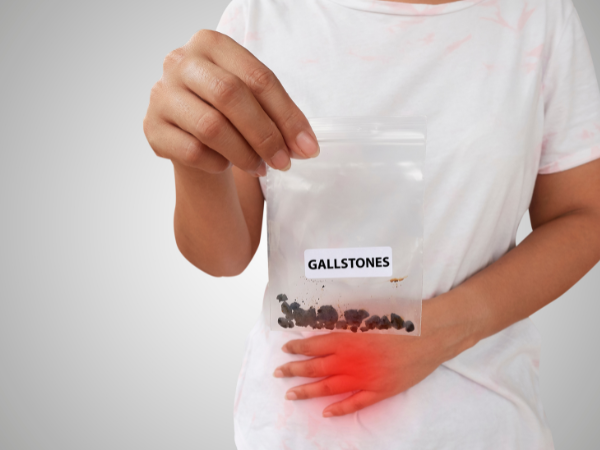How to Treat Gall Stones?
- December 21, 2023
- No Comments

What is Gallstones?
Gallstones, small, pebble-like structures, develop in the gallbladder, a small organ positioned beneath the liver. This organ is pivotal in digestion, storing bile—a liver-produced fluid crucial for breaking down fats. Gallstones come in various sizes, spanning from as small as grains of sand to as large as golf balls. They are solid deposits forming within the gallbladder, comprised mainly of cholesterol or bilirubin. These stones evolve as these substances accumulate and solidify over time. The gallbladder, resembling a small, pear-shaped organ, stores bile, which comprises cholesterol, bilirubin, bile salts, and lecithin. Gallstones emerge when there is an imbalance in these components. Cholesterol gallstones, the most prevalent type, result from an excess of cholesterol in bile. Alternatively, pigment gallstones form due to elevated bilirubin levels. These stones can range from minute particles to larger, golf ball-sized formations.
The growth of gallstones is gradual, occurring as bile continuously washes over them, collecting additional materials. Smaller stones pose a higher risk of complications as they can travel, potentially causing blockages when lodged in various ducts. In contrast, larger stones are more likely to remain stationary within the gallbladder. Two primary types of gallstones include cholesterol gallstones, composed predominantly of excess cholesterol, and pigment gallstones, formed from surplus bilirubin. The distinction in composition influences treatment approaches and outcomes. While surgery is a common method for addressing gallstones, natural remedies can be explored as alternatives. It is essential to consider various treatment options and preventive measures to manage gallstones effectively.
Why Do Gallstones Form?
The formation of gallstones commonly occurs due to a disruption in the equilibrium of the components constituting bile, including cholesterol, bile salts, and bilirubin. When these components are not properly balanced, they can crystallize and form stones. Numerous factors contribute to the development of gallstones, such as:
- Excess Cholesterol: If the bile contains too much cholesterol and not enough bile salts, it can lead to the formation of cholesterol stones.
- Excess Bilirubin: Conditions that cause an overproduction of bilirubin, a pigment produced when red blood cells are broken down, can result in the formation of pigment stones.
- Impaired Gallbladder Emptying: If the gallbladder does not empty properly or frequently enough, bile may become concentrated, increasing the likelihood of stone formation.
- Obesity: Being overweight or obese is a significant risk factor for gallstones, particularly in women.
- Rapid Weight Loss: Losing weight too quickly can lead to an increased concentration of cholesterol in the bile, promoting the formation of gallstones.
- Pregnancy: Hormonal changes during pregnancy can contribute to the formation of gallstones.
- Certain Diseases: Conditions such as diabetes and liver cirrhosis can increase the risk of gallstone formation.
How to Identify Gallstones?
Identifying gallstones often involves a combination of symptoms, physical examination, and diagnostic tests. Typical symptoms of gallstones comprise:
- Pain: The most common symptom is a sudden and intense pain in the upper right abdomen.
- Nausea and Vomiting: Gallstones can cause nausea and vomiting, especially after meals.
- Jaundice: If a gallstone blocks the bile duct, it can lead to jaundice, characterized by yellowing of the skin and eyes.
- Fever and Chills: Inflammation or infection of the gallbladder can cause fever and chills.
- Changes in Stool Color: Gallstones can lead to pale-colored stools due to a lack of bile reaching the intestines.
- Indigestion: Some individuals may experience indigestion and bloating.
Treatment Solutions for Gallstones:
Once gallstones are identified, several treatment options are available, ranging from lifestyle changes to medical interventions. The appropriate approach depends on the severity of symptoms and the type of gallstones present.
- Watchful Waiting: Asymptomatic gallstones may not require immediate treatment. In such cases, a "watch-and-wait" approach may be adopted, with regular monitoring and intervention only if symptoms develop.
- Dietary Changes: Adopting a low-fat diet can help manage symptoms and prevent the exacerbation of gallstones. This includes reducing the intake of fried foods, fatty meats, and processed snacks.
- Medications: Certain medications, such as ursodeoxycholic acid (UDCA), may be prescribed to dissolve cholesterol stones over time. However, this approach is not always effective, and the stones may recur once the medication is stopped.
- Extracorporeal Shock Wave Lithotripsy (ESWL): This non-invasive procedure uses shock waves to break gallstones into smaller pieces, making them easier to pass or dissolve. ESWL is typically reserved for certain cases and may not be suitable for everyone.
- Surgery (Cholecystectomy): The most common and definitive treatment for gallstones is the removal of the gallbladder through surgery, known as cholecystectomy. This can be done through traditional open surgery or minimally invasive laparoscopic techniques.
Benefits of Gallstone Treatment:
- Pain Relief: Treatment for gallstones aims to alleviate the severe pain associated with gallbladder attacks, improving the overall quality of life for affected individuals.
- Prevention of Complications: Untreated gallstones can lead to complications such as inflammation of the gallbladder (cholecystitis), infection, and blockage of the bile ducts. Timely intervention can prevent these complications.
- Improved Digestive Function: Removal of the gallbladder does not significantly impact digestive function. The body adapts to the absence of the gallbladder, and bile is released directly into the small intestine, allowing for the continued digestion of fats.
- Reduced Risk of Recurrence: Surgical removal of the gallbladder eliminates the possibility of gallstone recurrence, providing a long-term solution for individuals with symptomatic gallstones.
Comments (0)